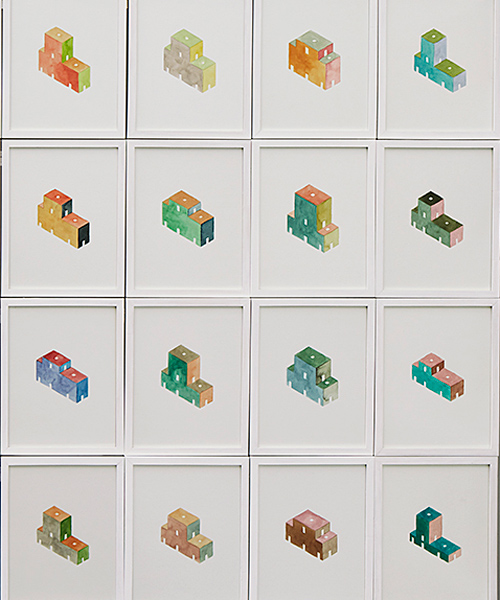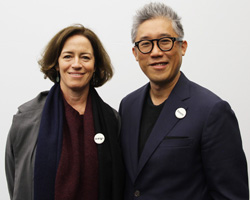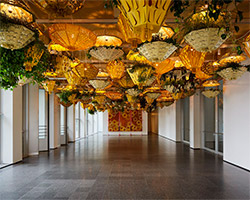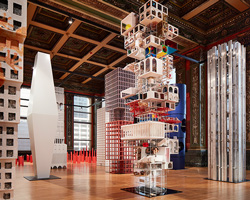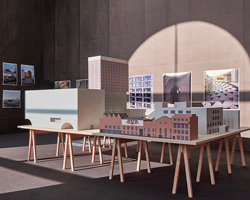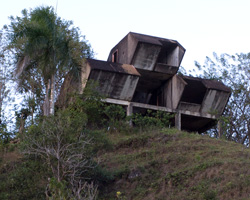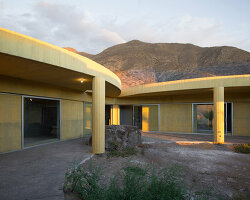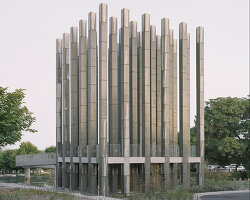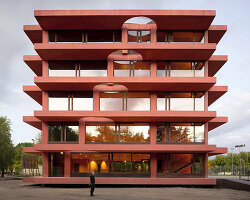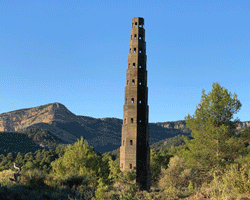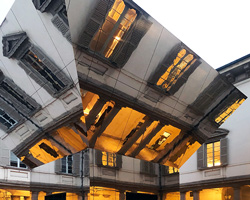at the chicago architecture biennial, pezo von ellrichshausen explores its ongoing interest in multiples. the chile-based studio, led and founded by mauricio pezo and sofia von ellrichshausen, underscores their embracement of art and architecture projects by organizing a monumental grid of 729 framed watercolor studies on the wall, demonstrating an almost mathematical obsession. the illustrated explorations depict the serial sequencing of an imagined building form that is half tower and half plinth.
designboom spoke with mauricio pezo and sofia von ellrichshausen about their contribution to the biennial, their response to the theme, and their amalgamation of art, architecture, and everything in between.
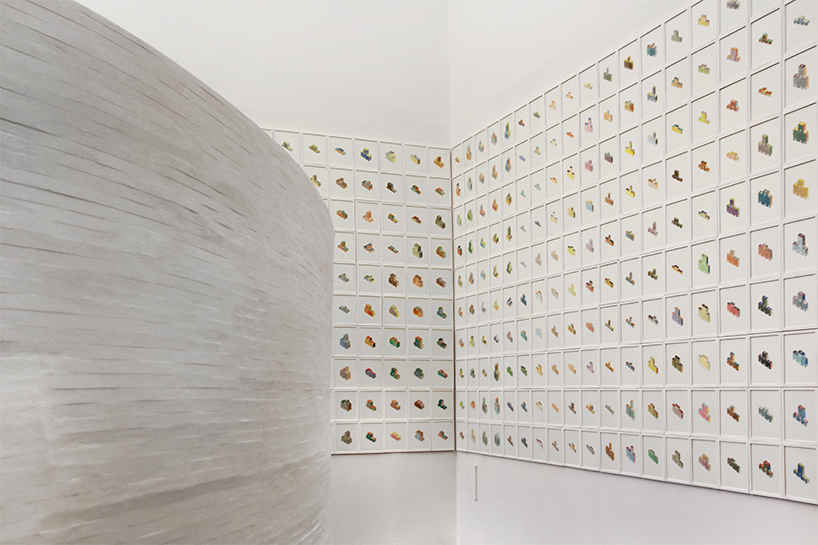
the installation explores pezo von ellrichshausen’s ongoing interest in multiples
image © designboom (main image by tom harris)
drawing from the long modernist tradition of architects that paint, pezo von ellrichshausen has realized a series of watercolor studies for the chicago architecture biennial in a seemingly random combination of 81 different colors. what appears to be an arbitrary arrangement of images is in fact ‘the systematic erosion of an ideal object, of an imaginary building, based on a prescribed set of rules,’ sofia von ellrichshausen tells designboom. the repetitive nature of ‘finite format 04’ suggests an influence from ‘serial art’ — a creative movement from the 1970s, which exhausted an idea or concept in a monotonous display.
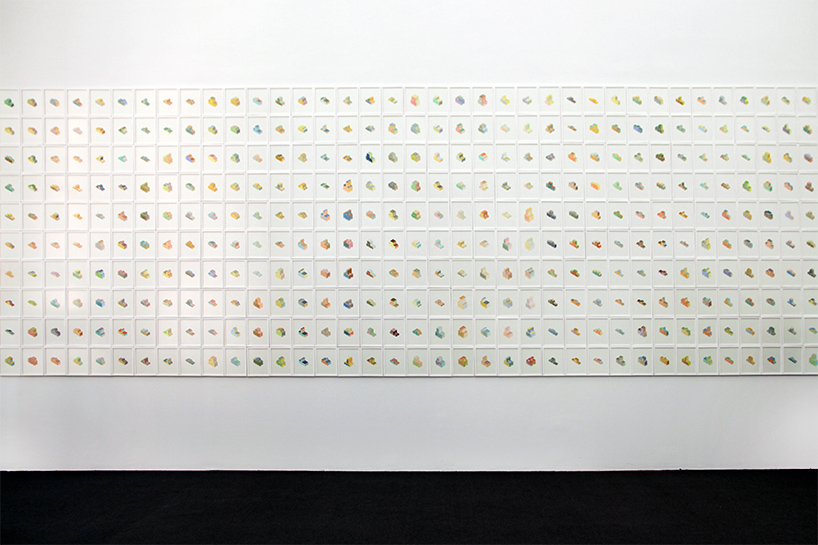
the chile-based studio is led and founded by mauricio pezo and sofia von ellrichshausen
image © designboom
designboom (DB): can you talk a bit about what you are presenting for this year’s chicago architecture biennial?
sofia von ellrichshausen (SVE): it is a 3.5m height by 20m long polyptych composed by 729 individual paintings, of watercolors on paper, organized on a seemingly random chromatic and formal arrangement. what appears to be an arbitrary array of minor variations is in fact the systematic erosion of an ideal object, of an imaginary building, based on a prescribed set of rules. this is the fourth iteration of an ongoing series we have entitled ‘finite format’.
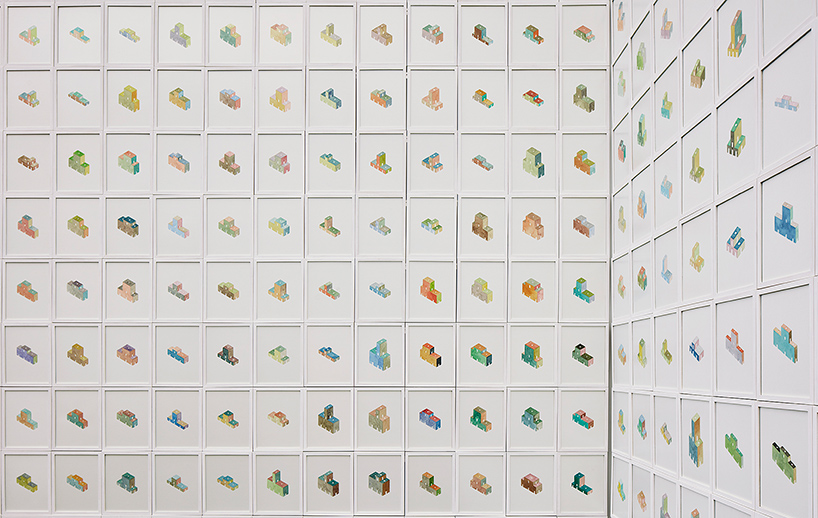
‘finite format 04’ underscores the studio’s embracement of art and architecture projects
image by tom harris
SVE (continued): it is a rather personal enquiry about the possibilities of a sort of ‘hand made’ formal determination in architecture. through a limited number of factors and dimensions we are studying how proportion is crucial for the understanding of character, disposition and identity of an architectonic piece. this comes from our interest in replacing the very notion of form by format. since it is a general outline, or a field of action defined by size and direction, we believe a format contains fundamental spatial attributes of a building.
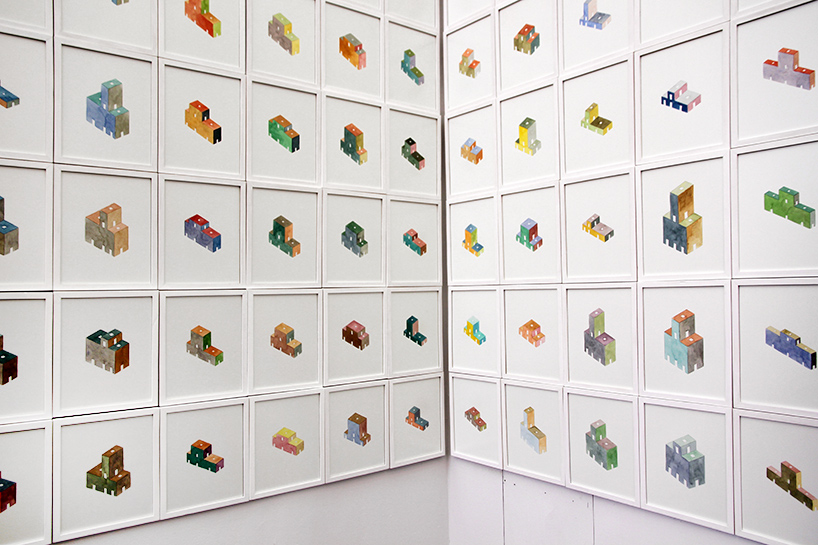
a monumental grid of 729 framed watercolor studies is organized on the wall
image © designboom
DB: how did you respond to the overall theme of ‘make new history’?
mauricio pezo (MP): since we never refer to anything beyond the building itself, and somehow assuming a tautological exercise, we are reading history as a wide source of knowledge. in our hypothetical approach, we are speculating with a potential idea of beginning, of the very moment in which history begins. of course, we are reading the call in conceptual terms, assuming history as a constructed fiction. we are indeed interested in basic and familiar forms.
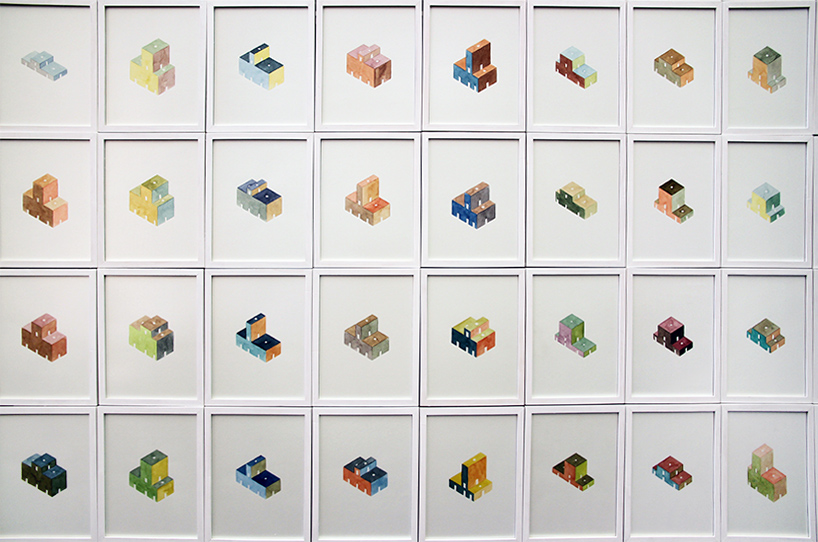
the studies demonstrate an almost mathematical obsession
image © designboom
MP (continued): in fact, not so much in those architectonic structures that are the starting point of a typology but in those that concentrate the most characteristic features of a certain kind. in other words, not in a prototype but in the archetype, in the model, the original idea for a building. the history is right there, at the beginning of a formal structure but also in the systematic transference, as in the hereditary metamorphosis within the same family, from one figure to the next one.
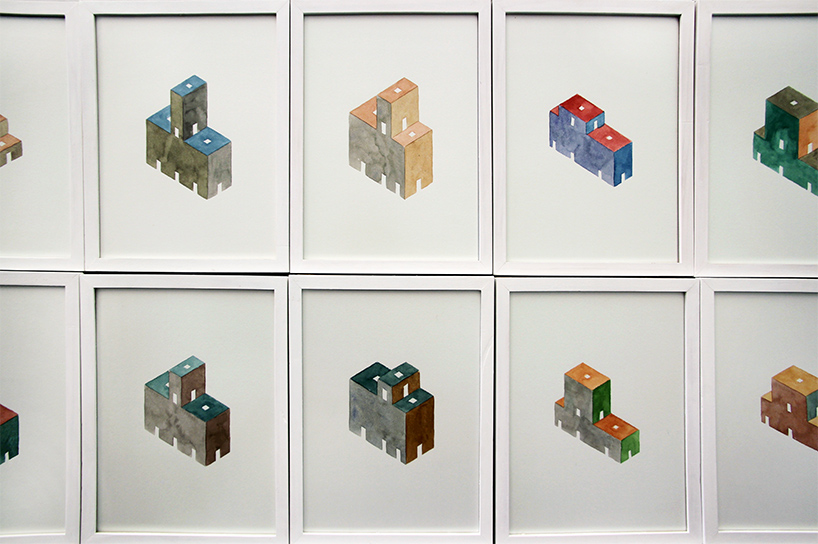
each of the illustrated explorations depict the serial sequencing of an imagined building
image © designboom
DB: in developing your contribution, how closely did you work with the biennial’s artistic directors sharon johnston and mark lee?
SVE: we have known sharon and mark for a long time now. I guess we have been exchanging ideas for many years, even before this official invitation. when they invited us, they already knew our recent work, both in art and architecture. although this is a new work, never exhibited before, they were extremely sensitive in giving this collection of paintings an adequate context. in abstract terms, they insisted in the relevant equivalence, or perhaps reciprocity, between building and representation, between an architectonic idea and its construction.
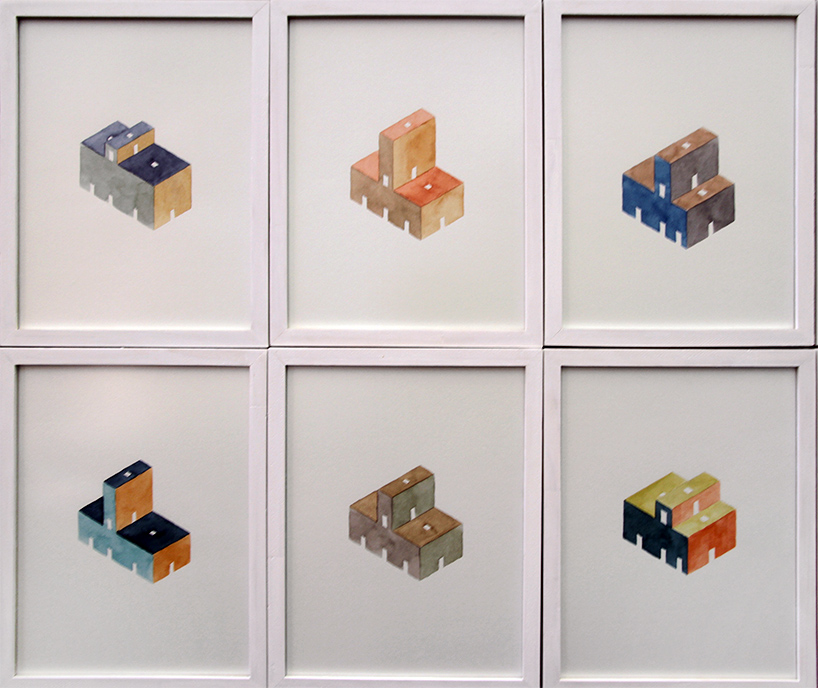
the architectural form is is half tower and half plinth
image © designboom
DB: do you enjoy creating temporary works for biennials etc., which have a potentially smaller and more intimate scale?
SVE: as much as we enjoy everything we accept to do. anyway, in our view, the scale of architecture has nothing to do with its size. this is a common misunderstanding; big buildings are not necessarily tackling the big scale, and vice versa. in fact, intimacy is a quality you might find in a massive, monumental structure.
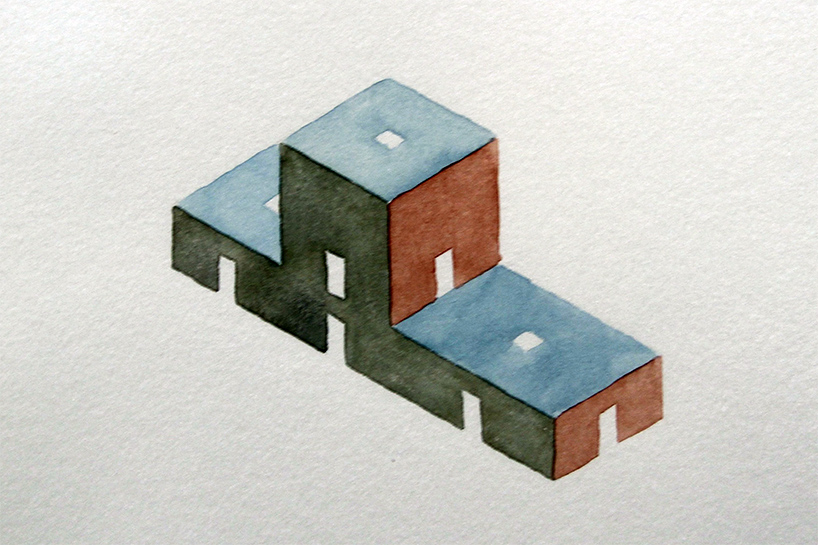
the studies draw from the long modernist tradition of architects who paint
image © designboom
DB: do you think it is important for the general public to be involved in the architectural discourse?
MP: not really. they need to be informed if the effects of buildings, or their impact on a street, a corner, a neighborhood or the city at large. not so much about their authors intentions. the so called general public, or lay people, just live and enjoy or suffer the consequences of the architect’s decision. and not even those decisions alone but every one of the circumstances that he or she had to face to take those decisions.
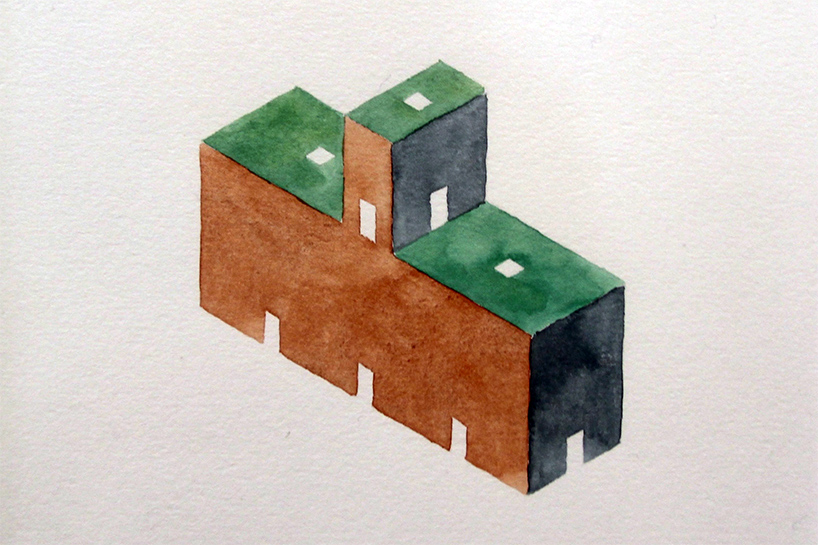
the drawings are configured in a seemingly random combination of 81 different colors
image © designboom
MP (continued): architectural discourses are fundamental for our disciplinary evolution, if evolution is what one is pursuing. they operate in a meta understanding of the current production, a sort of evaluation among peers, and later on as mere facts to be interpreted by historians. I suppose, the current architectural discourses are confusing popularity, market and politics. the social role of architecture is embedded in its function, both for individuals and collective dimensions. there seems to be a feeble line between the business of architecture and the good intentions to promote those businesses. I believe good architecture does not need to be explained.
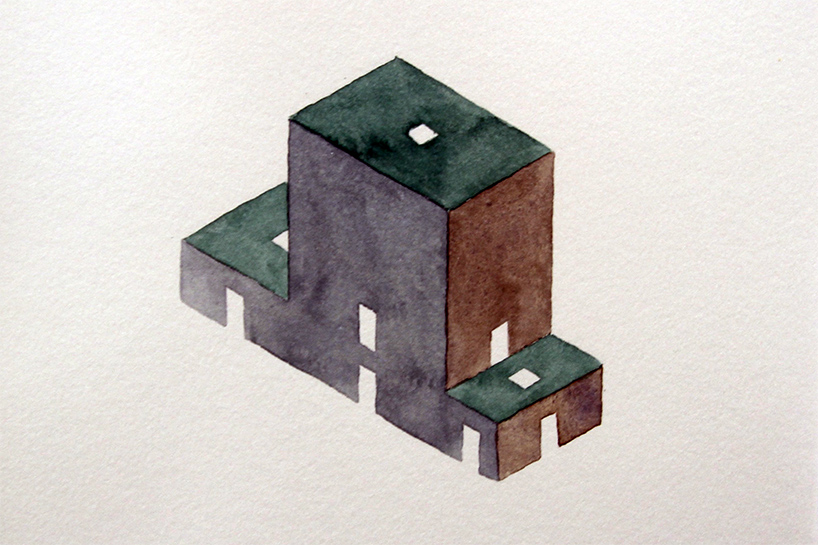
what appears to be an arbitrary arrangement of images is in fact ‘the systematic erosion of an ideal object’
image © designboom
DB: the biennial explores art, architecture, and everything in between. can you describe how your work covers different creative genres?
SVE: since our very beginning we have been producing both art and architecture. we have never paid so much attention to the disciplinary labels. they are useful in institutional terms but not in operative terms. we have been always doing paintings, drawings, photographs, models, pavilions, houses, etc. in many ways, we have been exploring up to what point we can find artistic qualities in a work of architecture and architectonic ones in a work of art.
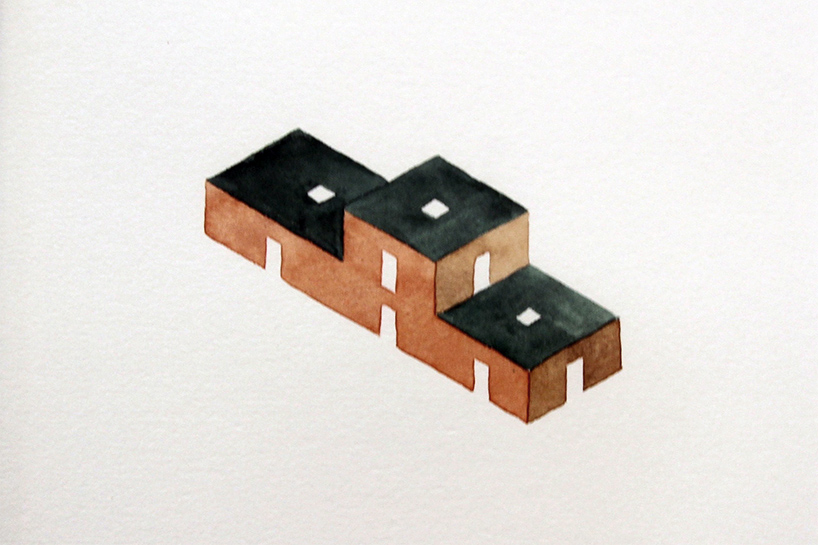
the building forms are based on a prescribed set of rules
image © designboom
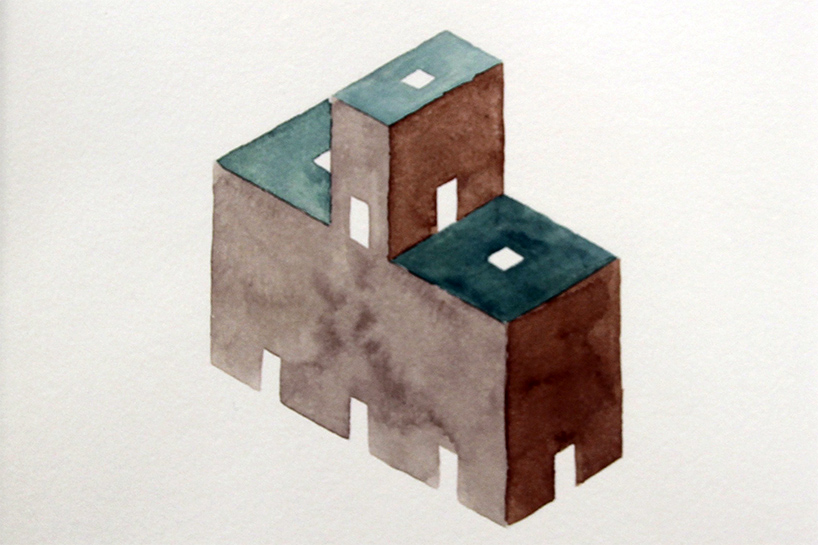
the repetitive nature of ‘finite format 04’ suggests an influence from ‘serial art’
image © designboom
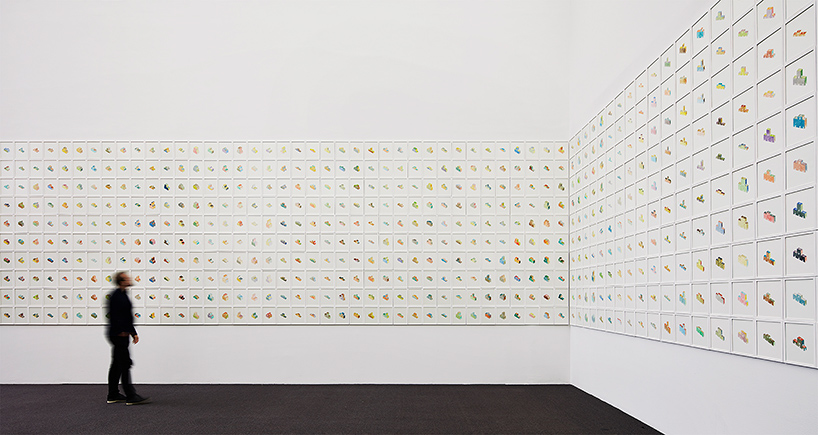
the project is presented during the second edition of the chicago architecture biennial
image by tom harris
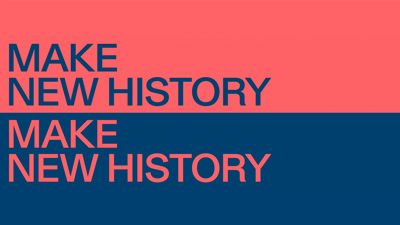
the second edition of the chicago architecture biennial (CAB) is the largest architecture and design exhibition in north america, showcasing the transformative global impact of creativity and innovation in these fields. this year’s biennial features over 141 practitioners from more than 20 countries addressing the 2017 theme ‘make new history.’ artistic directors sharon johnston and mark lee have selected architects and artists whose eye-opening creations will invite the public to explore how the latest architecture can and will make new history in places around the world.
CAB is hosted by the chicago department of cultural affairs and special events at the historic chicago cultural center. the ‘make new history’ exhibition extends to off-site locations and is amplified through six community anchor exhibitions in the neighborhoods and two special project sites — plus installations, performances, talks, films, and more hosted by over 100 local and global cultural partners.
the main exhibition is free and open to the public from september 16, 2017 through january 7, 2018.
Save
Save
Save
Save
Save
Save
Save
Save
Save
Save
Save
Save
Save
Save
Save
Save
chicago architecture biennial 2017 (15)
pezo von ellrichshausen (17)
PRODUCT LIBRARY
a diverse digital database that acts as a valuable guide in gaining insight and information about a product directly from the manufacturer, and serves as a rich reference point in developing a project or scheme.
